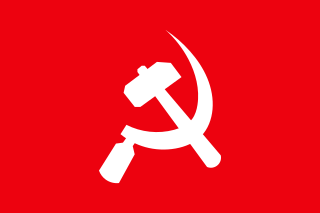
The Communist Party of India (Marxist–Leninist) was an Indian communist party formed by the All India Coordination Committee of Communist Revolutionaries (AICCCR) at a congress in Calcutta in 1969. The foundation of the party was declared by Kanu Sanyal at a mass meeting in Calcutta on 22 April, Vladimir Lenin's birthday. Later the CPI(ML) party splintered into several Naxalite groups.

Communist Party of India (Marxist-Leninist) is a anti-revisionist Marxist–Leninist communist party in India. After the death of Charu Majumdar in 1972 the Communist Party of India (Marxist-Leninist) pro Charu Majumdar central committee was led by Mahadev Mukherjee and Jagjit Singh Sohal, and the Central Committee took a stand to defend the line of Charu Majumdar on 5–6 December 1972.

Charu Majumdar, popularly known as CM, was a Communist leader from India, and founder of the Communist Party of India (Marxist-Leninist). Born into a progressive landlord family in Siliguri in 1918, he became a Communist during the Indian Independence Movement, and later formed the militant Naxalite cause. During this period, he authored the historic accounts of the 1967 Naxalbari uprising and his writings – particularly the Historic Eight Documents have become part of the ideology which guides the movement.
Communist Party of India (Marxist-Leninist) Second Central Committee or CPI (M-L) 2nd CC is a political party in India. It emerged in 1973 when the pro-Charu Majumdar faction of the original CPI (M-L) got divided into pro and anti-Lin Piao groups. The CPI (M-L) 2nd CC represents the pro-Lin Piao stream. At present, the party is active in states like Bihar, Uttar Pradesh and West Bengal.
Kanu Sanyal was an Indian communist politician. In 1967, he was one of the main leaders of the Naxalbari uprising and in 1969 he was one of the founding leaders of Communist Party of India (Marxist-Leninist). Sanyal committed suicide on 23 March 2010. He was born in a brahmin family
Communism in India (1925–1964) has existed as a social or political ideology as well as a political movement since at least as early as the 1920s. In its early years, communist ideology was harshly suppressed through legal prohibitions and criminal prosecutions. Eventually, communist parties became ensconced in national party politics, sprouting several political offshoots.
Vempatapu Satyanarayana (Satyam) was a schoolteacher, member of several Indian Communist organizations, and a leader of the Srikakulam peasant uprising of 1967, along with Adibhatla Kailasam and Subbarao Panigrahi. They had started the "land to tiller" movement in Andhra Pradesh, which later spread to South Orisa.

The Naxalite–Maoist insurgency, officially referred to as the Left Wing Extremism (LWE), is an ongoing conflict between Maoist groups known as Naxalites or Naxals and the Indian government. The influence zone of LWE is called the Red corridor, which has been steadily declining in terms of geographical coverage and number of violent incidents, and in 2021 it was confined to the 25 "most affected" locations and 70 "total affected" districts across 10 states in two coal-rich, remote, forested hilly clusters in and around the Dandakaranya-Chhattisgarh-Odisha region and the tri-junction area of Jharkhand-Bihar and-West Bengal. The Naxalites have frequently targeted tribal, police and government workers in what they say is a fight for improved land rights and more jobs for neglected agricultural labourers and the poor.
Jangal Santhal, also known as Jangal Santal from Hatighisa village, Darjeeling district in north West Bengal, was one of the founders of the Naxalite movement.
The Central Organising Committee, Communist Party of India (Marxist–Leninist) Party Unity, more commonly known as CPI(ML) Party Unity or simply 'Party Unity', was a communist party in India 1982-1998. Narayan Sanyal (politician) alias Naveen Prasad was the general secretary of the party. Party Unity was the official organ of the party. CPI(ML) Party Unity was one of the predecessors of the Communist Party of India (Maoist).
Santosh Rana was an Indian politician. In the 1960s, he was a prominent figure in the armed struggle of the Naxalites led by Charu Majumdar. Rana received Ananda Puraskar for his book Rajnitir Ek Jibon in 2018.
Satyanarayan Singh was an Indian communist politician. Singh was one of the early leaders of the Communist Party of India (Marxist-Leninist), being its secretary in Bihar.
Sushital Ray Chowdhary was an Indian Communist intellectual and founder member of Communist Party of India (Marxist-Leninist). He was the editor of the organs of the CPI, CPI(M) and CPI(ML). He eventually fell out with the mainstream Charu Majumdar group and died of a heart attack in March, 1971.

Saroj Dutta popularly known comrade SD, was an Indian communist intellectual and poet, active in the Naxalite movement in West Bengal in the 1960s. He was the first West Bengal state secretary of Communist Party of India (Marxist-Leninist). He also remained editor-in-chief of the Amrita Bazar Patrika during the 1940s.
The Srikakulam peasant uprising occurred from 1967 to 1970, in Srikakulam district, Andhra Pradesh, India. The Naxalbari uprising at the beginning of the Naxalite movement during the 1960s inspired the upsurge.

Naxalbari uprising was an armed peasant revolt in 1967 in the Naxalbari block of Siliguri subdivision in Darjeeling district, West Bengal, India. It was mainly led by tribals and the radical communists leaders of Bengal and further developed into the Communist Party of India (Marxist–Leninist) in 1969. The armed struggle became an inspiration to the naxalite movement which rapidly spread from West Bengal to other states of India creating division within in to the CPI(M) Party.
Dilip Bagchi was a Bengali mass singer, educationist and political activist. He was an active member of Indian People's Theatre Association of West Bengal.
Central Organising Committee, Communist Party of India (Marxist–Leninist) was a communist party in India, one of the main splinter factions of the original Communist Party of India (Marxist–Leninist). COC, CPI(ML) occupied a middle position between the pro-Charu Majumdar group led by Mahadev Mukherjee and the anti-Majumdar group led by Satyanarayan Singh. Failing to articulate a common ideological position, COC, CPI(ML) soon suffered internal divisions and splits. Two of the splinter groups of COC, CPI(ML) in Andhra Pradesh are predecessors of the present-day Communist Party of India (Maoist).
Baccha Prasad Singh alias Balraj alias Arvind is an Indian Maoist politician and Politburo member of Communist Party of India (Maoist)







